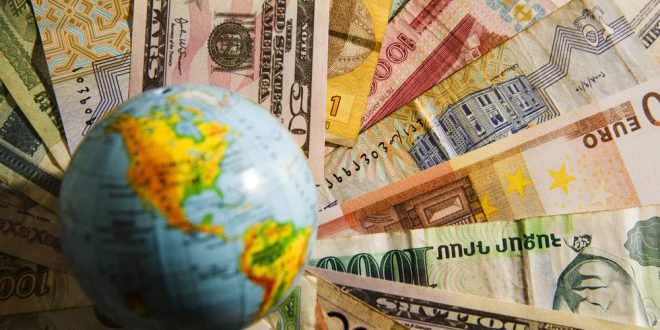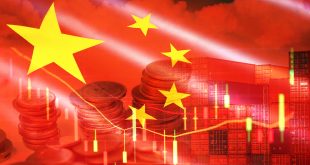The US dollar continued to rise on Friday, taking advantage of the negative factors that dominated the markets last week with Federal Reserve officials and their statements to raise interest rates at a faster pace.
The euro and the British pound fell to a one-month low against the safe-haven US dollar on Friday as investors grew increasingly concerned about a further economic slowdown after Federal Reserve officials reiterated that a rate hike is needed.
The dollar index rose 0.2% to 107.69 after touching 107.74 earlier, the highest level since July 18. The index is on track to gain 1.9% this week, its best weekly performance in ten weeks.
The euro settled at $1.0084 after touching its lowest level since July 15. Sterling fell 0.4% to a one-month low of $1.1882.
US stocks fell on Friday amid a broad-based sell-off led by major companies as US bond yields rose, while the Standard & Poor’s 500 index posted a weekly loss after a four-week winning streak.
The shares of Amazon, Apple and Microsoft declined and were among the biggest decliners on the Standard & Poor’s and Nasdaq indices. Technology stocks and growth-related stocks are negatively affected by higher interest rates as estimates of their value depend heavily on forward cash flows.
US Treasury yields rose, with benchmark 10-year Treasuries reaching nearly 3 percent after Germany announced record monthly producer price increases.
Investors were anticipating the extent of the Federal Reserve’s monetary policy, which is currently focused on raising interest rates to fight inflation.
The Dow Jones Industrial Average lost 292.3 points, or 0.86 percent, to 33706.74 points. S&P 500 index fell 55.26 points, or 1.29 percent, to 4,228.48 points, and the Nasdaq Composite Index fell 260.13 points, or 2.01 percent, to 12,705.22 points.
Fed minutes
After release of the Fed minutes, markets placed roughly 40% odds of a 75-basis-point rate hike on Sept. 21. That’s a bit lower than after the Fed’s July 27 meeting.
Still, optimism about a pivot to Fed rate cuts in the first half of 2023 has begun to fade. Markets now see the Fed’s key rate rising to a target range of 3.5%-3.75% as early as December from the current federal funds target range of 2.25%-2.5%.
Fed policymakers have estimated the long-term neutral rate to be around 2.4%. However, given that inflation is running near four-decade highs, many economists see neutral as higher at the moment. Even dovish San Francisco Fed branch president Mary Daly has since said that she sees the neutral rate around 3.1%.
The minutes also seemed to push back against market expectations for a dovish pivot, which had already helped spark a six-week stock market rally following the June 14-15 meeting.
“In light of elevated inflation and the upside risks to the outlook for inflation, participants remarked that moving to a restrictive stance of the policy rate in the near term would also be appropriate from a risk-management perspective,” the minutes state. That would “better position” the Fed to hike further into restrictive territory, if needed.
RBNZ
New Zealand raised its key interest rate by another half-percentage point and sees it climbing to at least 4%, cementing the central bank’s place at the forefront of global tightening.
The Monetary Policy Committee lifted the Official Cash Rate to 3% as expected on Wednesday, while increasing and bringing forward its forecast rate peak. That commitment to further tightening sent the currency and policy-sensitive two-year government bond yield higher.
Oil
Oil prices fell on Friday, after two days of gains, and are on track to post a weekly loss on pressure from the strong dollar and fears of a global economic slowdown.
Brent crude futures were down 97 cents, or 1 percent, at $95.62 a barrel by 0826 GMT. US West Texas Intermediate crude also recorded $89.59 a barrel, down 91 cents, or one percent.
Both benchmark contracts are heading to record weekly losses of close to three percent.
The dollar’s strength increased the cost of oil to holders of other currencies, while Asian and European stocks declined.
In a sign that the oil supply bottleneck is easing, the gap between the spot price of Brent and the second nearest expiry month for futures contracts is nearly $5 less than at the end of July.
Limiting the decline in prices, US crude stocks fell sharply, with a record amount of five million barrels of oil per day being exported in the last week, as oil companies received requests from European countries seeking to compensate for Russian crude.
Haitham al-Ghais, the new Secretary-General of the Organization of the Petroleum Exporting Countries (OPEC), told Reuters that he is optimistic about oil demand next year.
He added before a meeting to be held on the fifth of September that OPEC is keen to ensure that Russia remains within the OPEC + alliance.
Europe
European shares fell on Friday, ending the week’s trading with a loss, after the highest increase in producer prices in Germany in July contributed to strengthening the pessimistic view of the economic outlook for the region’s largest economy and once again raised fears of a recession.
The pan-European Stoxx 600 index closed 0.8 percent lower, led by travel stocks.
Rising energy prices due to the Ukraine war pushed German producer costs in July to an all-time high on an annual and monthly basis. Energy prices also jumped 105 percent compared to July 2021.
The German DAX index lost 1.1%, the largest decline among its peers on the continent, and its 10-year yields rose to their highest level in four weeks.
UK Inflation
The UK Consumer Prices Index (CPI) 12-month rate came in at 10.1% in July when compared to 9.4% seen in June while beating estimates of a 9.8% score, the UK Office for National Statistics (ONS) reported on Wednesday. The index hit the highest level since 1982.
Meanwhile, the core inflation gauge (excluding volatile food and energy items) rose to 6.2% YoY last month versus 5.8% booked in May, outpacing the market consensus of 5.9%.
The monthly figures showed that the UK consumer prices climbed by 0.6% in July vs. 0.4% expectations and 0.8% previous.
The UK Retail Price Index for July arrived at 0.9% MoM and 12.3% YoY, beating estimates across the time horizon.
Uk Retail Sales
The UK retail sales arrived at 0.3% over the month in July vs. -0.2% expected and -0.1% previous. The core retail sales, stripping the auto motor fuel sales, jumped 0.4% MoM vs. -0.2% expected and 0.4% previous.
On an annualized basis, the UK retail sales plunged -3.4% in July versus -3.3% expected and -6.1% prior while the core retail sales fell by 3.0% in the reported month versus -3.1% expectations and -6.2% previous.
 Noor Trends News, Technical Analysis, Educational Tools and Recommendations
Noor Trends News, Technical Analysis, Educational Tools and Recommendations





